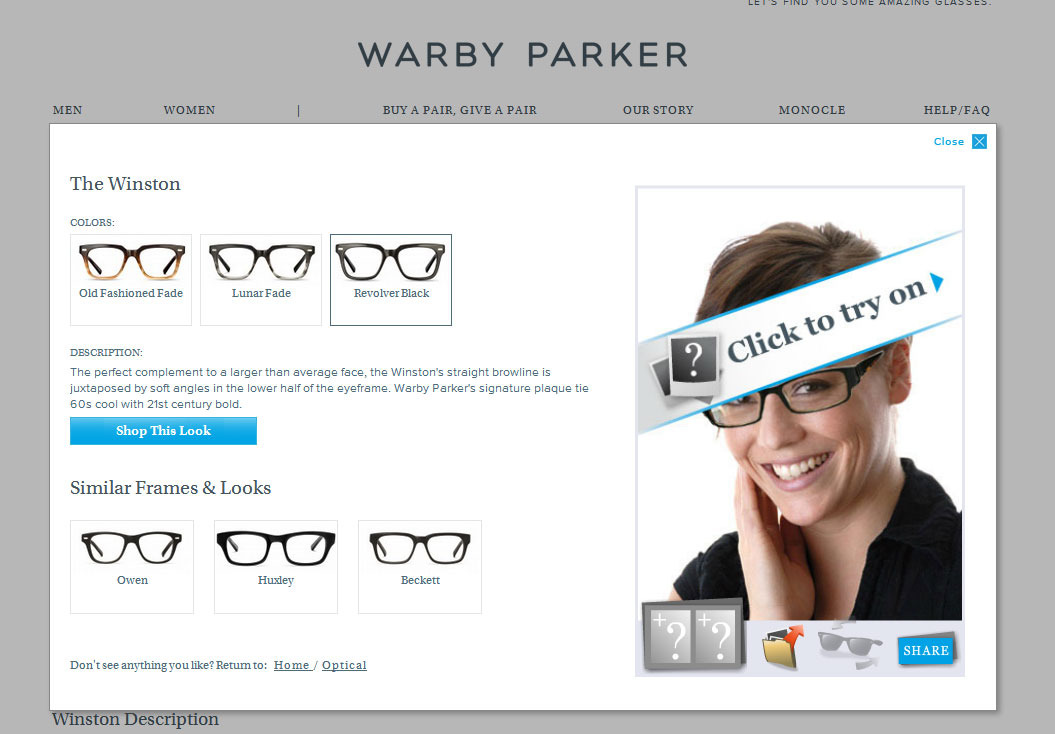
Online retail showcasing will drive $558 million of spending this year on the technologies, IDC estimated.Warby Parker has an impressive selection including many goofy pairs for silly goose selfies to keep guys like me entertained. Warby Parker's new feature is an attempt to streamline its own purchasing process for customers through more accurate virtual try-ons. Worldwide spending on AR and virtual reality is forecast to grow 68.8% to about $20.4 billion this year, according to the International Data Corporation. Fast-fashion retailer Zara last year launched a mobile AR tool that let in-store shoppers view virtual images of models wearing different items from nearby displays, and guided them through buying the selected merchandise through the app. While many brands are creating strictly mobile features, some are dabbling in the "brick-and-mobile" space as a way to merge mobile technology with in-store shopping. For example, designer brand Michael Kors ran an AR ad campaign on Facebook in 2018 that let shoppers virtually try on a pair of sunglasses and buy them without ever leaving the app, further reducing friction in the buying process. Sports brand Adidas in December partnered with Snapchat for a lens that let mobile users virtually try on a new running shoe using AR and a smartphone. Warby Parker is among the fashion brands and retailers - particularly DTC companies - working to integrate more immersive technology to complement their e-commerce and in-store experiences for shoppers.
WARBY PARKER VIRTUAL TRY ON SOFTWARE
The retailer had to revise the software repeatedly to refine it, she said. Because glasses often become such a key part of a person's appearance, it remains to be seen whether the AR technology will completely replace physical try-ons any time soon. Unlike face filters that apps like Snapchat overlay on a person's face, glasses need to more closely align with facial features, including the wearer's ears, eyes and nose. The new AR try-on tool now helps customers on iPhones narrow their choices earlier in the shopping journey and reduce the need to receive multiple shipments of frames, eliminating extra costs for Warby Parker and saving customers' time.Įrin Collins, Warby Parker's senior director of e-commerce and consumer insights, said the company faced bigger technical hurdles in developing the AR try-ons with last year's test of a website version. Warby Parker has built a DTC business on home try-ons of glasses and sunglasses, sending five pairs of frames to shoppers to test out before sending them back with a final selection. Shoppers also can take a screenshot to share with friends and get a second opinion on styles. Warby Parker's app uses a proprietary algorithm to more accurately place the virtual frames on a user's face.
Because Warby Parker's new virtual try-ons rely on the same technology that powers Apple's FaceID feature, it's only available on the iPhone X or newer models.


Warby Parker, the direct-to-consumer (DTC) retailer of prescription glasses, introduced a virtual try-on tool in its iPhone app that lets shoppers pick frames and see how they look with an augmented reality (AR) overlay.


 0 kommentar(er)
0 kommentar(er)
